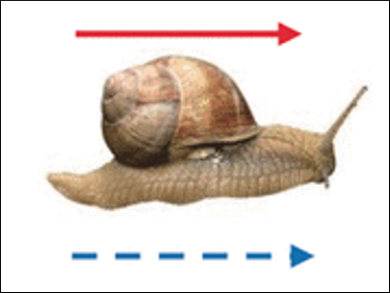Building a Model for Crawling Motions
Directed motion seems simple to us, but the coordinated interplay of complex processes is needed, even for seemingly simple crawling motions of worms or snails. By using a gel that periodically swells and shrinks, researchers developed a model for the waves of muscular contraction and relaxation involved in crawling. As reported in the journal Angewandte Chemie, they were able to produce two types of crawling motion by using inhomogeneous irradiation.
Crawling comes from waves that travel through muscle. These waves can travel in the same direction as the animal is crawling (direct waves), from the tail end toward the head, or in the opposite direction (retrograde waves), from the head toward the tail. While land snails use the former type of wave, earthworms and limpets use the latter. Chitons (polyplacophora) can switch between both types of movement.
Self-oscillating Gel
With the aid of a chemical model in the form of a self-oscillating gel, researchers working with Qingyu Gao at the China University of Mining and Technology, Jiangsu, and Irving R. Epstein at Brandeis University, Waltham, MA, USA, have been able to answer some of the many questions about these crawling processes.
A gel is a molecular network with liquid bound in the gaps. In this case, the liquid contains all of the ingredients needed for an oscillating chemical reaction (“chemical clock”). The researchers incorporated one component of their reaction system into the network: a ruthenium complex. During the reaction, the ruthenium periodically switches between two oxidation states, Ru2+ and Ru3+. This switch changes the gel so that in one state it can hold more liquid than the other, thus, the gel swells and shrinks periodically. Like the chemical clock, these regions propagate in waves, similar to the waves of muscle contractions in crawling.
Using Light to Change Directions
The complex used in this gel also changes oxidation state when irradiated with light. When the right half of the gel is irradiated more strongly than the left, the waves move from right to left, i.e., from a high- to a low-frequency region of gel oscillations. Once the difference in intensity of irradiation reaches a certain threshold, it causes a wormlike motion of the gel from left to right, retrograde wave locomotion. If the difference is increased further, the gel comes to a stop. A further increase in the difference causes the gel to move again, but in the opposite direction, i.e., direct wave locomotion.
The nonuniform illumination plays a role analogous to that of anchoring segments and appendages (such as limbs and wings) during cell migration and animal locomotion, which control the direction of locomotion by strengthening direct movement and/or inhibiting the opposite movement.
Push and Pull Regions
Using computational models, the researchers were able to describe these processes. Within the gel, there are regions where pulling forces predominate; pushing forces predominate in other areas. Variations in the intensity of the irradiation lead to different changes in the friction forces and the tensions in the gel. When these effects are added up, it is possible to predict in which direction a particular grid element of the gel will move.
One important finding from this model: special changes in the viscoelastic properties of the slime excreted by the snails and worms as they crawl are not required for locomotion, whether retrograde or direct.
- Retrograde and Direct Wave Locomotion in a Photosensitive Self-Oscillating Gel,
Lin Ren, Weibing She, Qingyu Gao, Changwei Pan, Chen Ji, Irving R. Epstein,
Angew. Chem. Int. Ed. 2016.
DOI: 10.1002/anie.201608367




